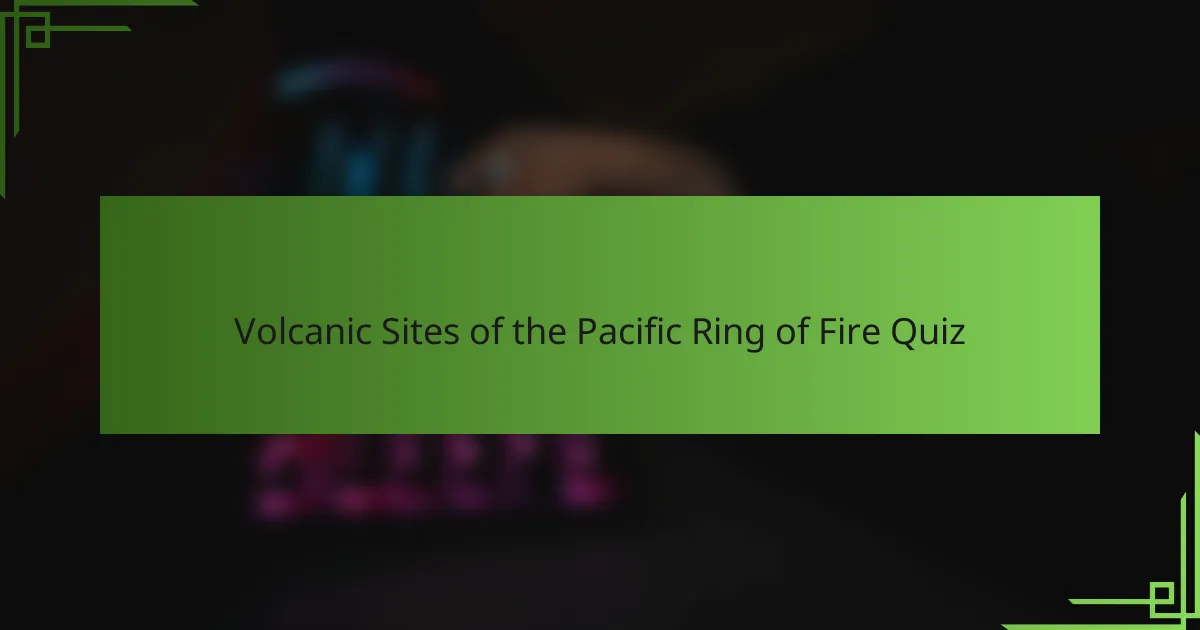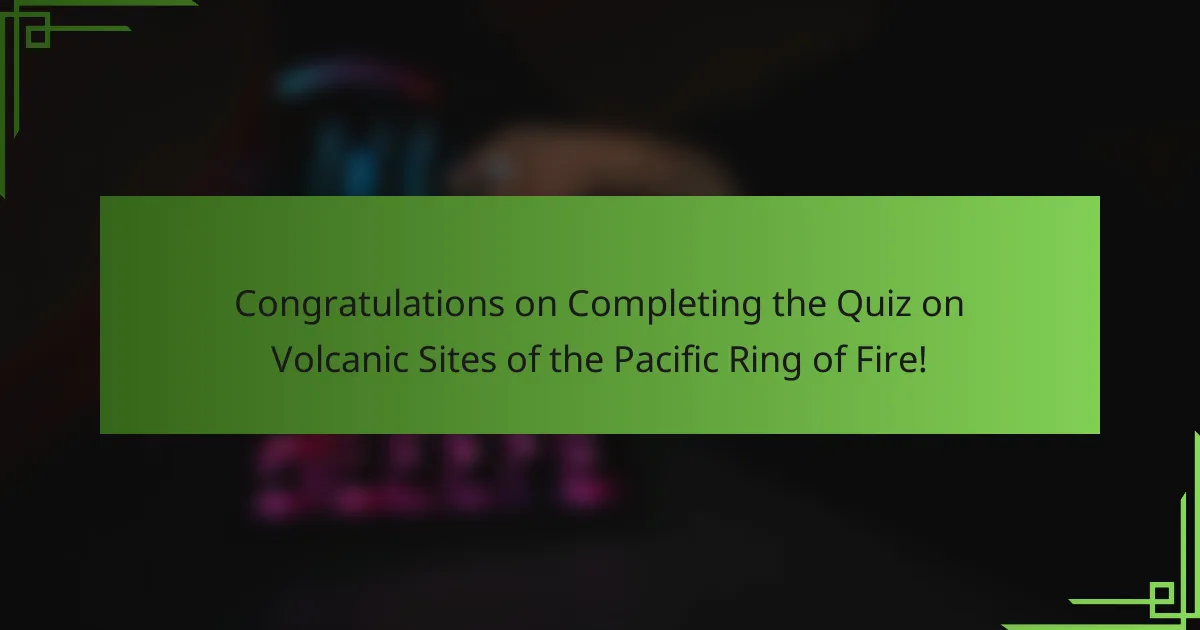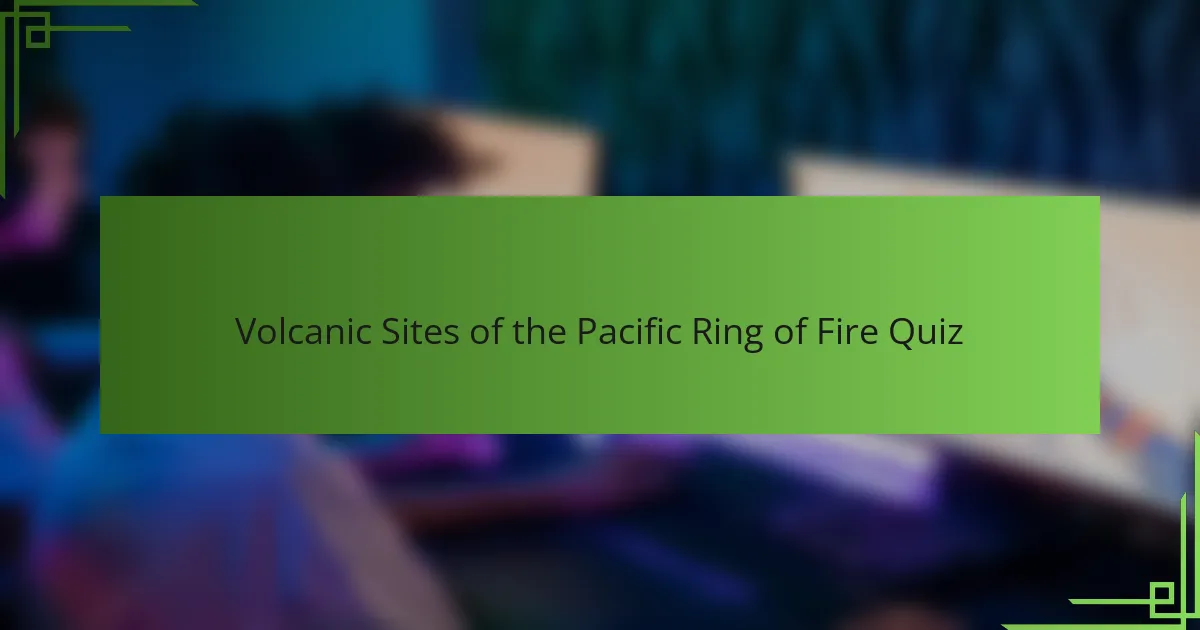
Volcanic Sites of the Pacific Ring of Fire Quiz
1. Which volcanic site in Japan is one of the most active volcanoes located on the Pacific Ring of Fire?
- Mount Sakurajima
- Mount Asama
- Mount Fuji
- Mount Unzen
2. What is the name of the massive volcano in Indonesia known for the 1815 eruption that affected global climate?
- Mount Merapi
- Mount Bromo
- Mount Tambora
- Mount Krakatoa
3. Which volcano in the Philippines is famous for its near-perfect cone shape and is part of the Pacific Ring of Fire?
- Mount Bulusan
- Taal Volcano
- Mount Pinatubo
- Mayon Volcano
4. Mount St. Helens, known for its 1980 eruption, is located in which US state along the Pacific Ring of Fire?
- Washington
- Alaska
- California
- Oregon
5. What volcanic island in New Zealand is part of the Pacific Ring of Fire and known for its geothermal activity?
- Stewart Island
- Rangitoto Island
- White Island (Whakaari)
- Great Barrier Island
6. Which volcano in Chile is part of the Andes mountain range and is one of the most active along the Pacific Ring of Fire?
- Calbuco
- Llaima
- Osorno
- Villarrica
7. The Kilauea volcano, one of the most active in the world, is located on which Hawaiian island in the Pacific Ring of Fire?
- Oahu
- Hawaii Island
- Maui
- Kauai
8. Which prominent stratovolcano is located on the Kamchatka Peninsula in Russia and is part of the Pacific Ring of Fire?
- Mount Fuji
- Mount Etna
- Klyuchevskaya Sopka
- Mount St. Helens
9. Mount Fuji, an iconic volcanic mountain, is situated in which country within the Pacific Ring of Fire?
- Indonesia
- Taiwan
- Philippines
- Japan
10. The Taupo Volcanic Zone, containing several active volcanoes, is part of which country in the Pacific Ring of Fire?
- Indonesia
- Japan
- Philippines
- New Zealand
11. Which volcanic site in Alaska experienced a major eruption in 1912, one of the largest of the 20th century?
- Mount Redoubt
- Mount Katmai
- Novarupta
- Mount Spurr
12. Mount Etna is a well-known volcano, but it is not in the Pacific Ring of Fire; which European country hosts another major volcanic site in this ring?
- Iceland
- Greece
- Italy
- Spain
13. Which volcano in Guatemala, part of the Pacific Ring of Fire, is known for its frequent eruptions and proximity to Antigua?
- Volcán Pacaya
- Volcán de Fuego
- Volcán Acatenango
- Volcán Agua
14. The Aleutian Islands are part of the Pacific Ring of Fire; which US state do these islands belong to?
- Alaska
- Washington
- California
- Oregon
15. Which volcanic lake, formed in a caldera on the island of Luzon, Philippines, is part of the Pacific Ring of Fire?
- Taal Lake
- Lake Naujan
- Lake Caliraya
- Laguna de Bay

Congratulations on Completing the Quiz on Volcanic Sites of the Pacific Ring of Fire!
You’ve just explored some of the most dynamic and fascinating volcanic locations along the Pacific Ring of Fire. This quiz was designed to deepen your understanding of how tectonic activity shapes Earth’s geography. You likely gained insights into key volcanoes, their locations, and the natural processes behind their formation. Understanding these sites helps reveal the powerful forces at work beneath the Earth’s surface.
As you discovered, the Pacific Ring of Fire hosts many of the world’s most active and impactful volcanoes. These volcanic sites influence the landscapes, weather, and even human history of the surrounding regions. Recognizing these factors enriches your grasp of geology and geography. It also highlights the importance of monitoring volcanic activity for environmental safety and disaster preparedness.
To continue expanding your geographical knowledge, be sure to check out the next section on this page. There, you will find more detailed information and fascinating facts about the volcanic sites of the Pacific Ring of Fire. This additional content will build on what you’ve learned and offer new perspectives on these remarkable natural features.

Volcanic Sites of the Pacific Ring of Fire
Geographical Overview of the Pacific Ring of Fire
The Pacific Ring of Fire is a horseshoe-shaped zone that encircles the Pacific Ocean basin. It is characterized by intense seismic and volcanic activity. This area hosts about 75% of the world’s active and dormant volcanoes. The Ring of Fire spans continents and islands including parts of Asia, North America, South America, and Oceania. Its formation is due to tectonic plate boundaries and subduction zones along the Pacific Plate. This geological setting results in frequent volcanic eruptions and earthquakes.
Main Volcanic Zones within the Pacific Ring of Fire
The Ring of Fire contains several key volcanic arcs and regions. These include the Aleutian Islands in Alaska, the Cascade Range in the northwestern United States, the Andes Mountain range in South America, and the islands of Japan, Indonesia, and the Philippines. Each zone contains numerous stratovolcanoes and volcanic complexes formed by subduction processes. The Andes, for example, feature prominent volcanoes like Cotopaxi and Villarrica, illustrating the volcanic activity along this expansive belt.
Significant Volcanoes in the Pacific Ring of Fire
Several notable volcanoes define the volcanic landscape of the Ring of Fire. Mount Fuji in Japan is an iconic stratovolcano and cultural symbol. Mount St. Helens in the United States is known for its catastrophic 1980 eruption. In Indonesia, Mount Merapi is one of the most active volcanoes globally. These volcanoes exemplify diverse eruption styles and volcanic hazards across the region. Their activity is continuously monitored to mitigate risks to populated areas.
Formation and Plate Tectonics of Volcanic Sites in the Pacific Ring of Fire
The volcanic activity in the Pacific Ring of Fire results primarily from subduction zones where oceanic plates converge with continental or other oceanic plates. The Pacific Plate subducts beneath surrounding plates such as the North American Plate, the Eurasian Plate, and the Indo-Australian Plate. This process generates magma from the melting of the descending plate, which rises to form volcanoes. This tectonic interaction shapes the geography and distribution of volcanic sites around the Pacific basin.
Volcanic Hazards and Their Geographic Impact in the Pacific Ring of Fire
Volcanic sites in the Pacific Ring of Fire pose significant hazards including eruptions, ashfall, pyroclastic flows, and lahars. These hazards affect dense populations in countries such as Japan, Indonesia, and the Philippines. For example, the 1991 eruption of Mount Pinatubo in the Philippines caused widespread devastation and global climatic effects. The geography of the Ring of Fire amplifies risks through geological instability and proximity to urban centers along coasts and volcanic slopes.
What are the Volcanic Sites of the Pacific Ring of Fire?
The Volcanic Sites of the Pacific Ring of Fire are a series of active and dormant volcanoes located along the edges of the Pacific Ocean basin. These sites include famous volcanoes such as Mount St. Helens in the United States, Mount Fuji in Japan, and Mount Pinatubo in the Philippines. The Ring of Fire is characterized by frequent earthquakes and volcanic eruptions caused by tectonic plate movements along convergent and transform boundaries. This region contains about 75% of the world’s active and dormant volcanoes, making it the most volcanically active area on Earth.
How do volcanoes in the Pacific Ring of Fire form?
Volcanoes in the Pacific Ring of Fire form primarily through subduction, where one tectonic plate moves beneath another and sinks into the mantle. This process generates magma due to melting of the subducting plate and surrounding mantle material. The magma rises through the Earth’s crust, leading to volcanic eruptions at the surface. For example, the subduction of the Pacific Plate under the North American Plate creates volcanic activity along the western coast of the Americas, demonstrating the typical formation mechanism of Ring of Fire volcanoes.
Where are some of the most significant volcanic sites located in the Pacific Ring of Fire?
Significant volcanic sites in the Pacific Ring of Fire are located in countries bordering the Pacific Ocean, including the United States (Mount St. Helens, Mount Rainier), Japan (Mount Fuji, Sakurajima), Indonesia (Mount Merapi, Krakatoa), the Philippines (Mount Mayon, Mount Pinatubo), and New Zealand (Mount Ruapehu, White Island). Each of these sites is situated along tectonic plate boundaries responsible for active volcanism in this region.
When have major volcanic eruptions occurred in the Pacific Ring of Fire?
Major volcanic eruptions in the Pacific Ring of Fire have occurred at various times, including the 1980 eruption of Mount St. Helens in Washington State, the 1991 eruption of Mount Pinatubo in the Philippines, and the 1883 eruption of Krakatoa in Indonesia. These eruptions were among the most powerful of the 20th century and caused widespread environmental and human impact, illustrating when significant volcanic events have shaped the region’s history.
Who monitors and studies the volcanic activity in the Pacific Ring of Fire?
Volcanic activity in the Pacific Ring of Fire is monitored and studied by national geological agencies and international organizations. Examples include the United States Geological Survey (USGS) in the U.S., the Japan Meteorological Agency (JMA) in Japan, the Philippine Institute of Volcanology and Seismology (PHIVOLCS), and the Indonesian Center for Volcanology and Geological Hazard Mitigation (PVMBG). These agencies use seismic data, satellite imagery, and field observations to track volcanic activity and assess potential hazards.
